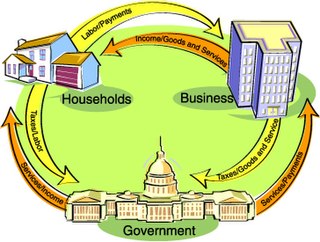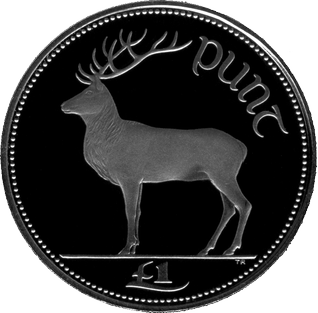Related Research Articles
A currency in the most specific sense is money in any form when in use or circulation as a medium of exchange, especially circulating banknotes and coins. A more general definition is that a currency is a system of money in common use, especially for people in a nation. Under this definition, U.S. dollars (US$), euros (€), Indian Rupee (₹), Japanese yen (¥), and pounds sterling (£) are examples of currencies. These various currencies are recognized as stores of value and are traded between nations in foreign exchange markets, which determine the relative values of the different currencies. Currencies in this sense are defined by governments, and each type has limited boundaries of acceptance.

ISO 4217 is a standard published by International Organization for Standardization (ISO) that defines alpha codes and numeric codes for the representation of currencies and provides information about the relationships between individual currencies and their minor units. This data is published in three tables:

The yen is the official currency of Japan. It is the third most traded currency in the foreign exchange market after the United States dollar and the Euro. It is also widely used as a third reserve currency after the U.S. dollar and the Euro.
The Australian dollar is the currency of Australia, including its external territories: Christmas Island, Cocos (Keeling) Islands, and Norfolk Island. It is officially used as currency by three independent Pacific Island states: Kiribati, Nauru, and Tuvalu. It is legal tender in Australia. Within Australia, it is almost always abbreviated with the dollar sign ($), with A$ or AU$ sometimes used to distinguish it from other dollar-denominated currencies. The $ symbol precedes the amount. It is subdivided into 100 cents.
The New Zealand dollar is the official currency and legal tender of New Zealand, the Cook Islands, Niue, the Ross Dependency, Tokelau, and a British territory, the Pitcairn Islands. Within New Zealand, it is almost always abbreviated with the dollar sign ($), with "NZ$" sometimes used to distinguish it from other dollar-denominated currencies. In the context of currency trading, it is often informally called the "Kiwi" or "Kiwi dollar", since New Zealand is commonly associated with the kiwi and the one-dollar coin depicts the indigenous bird on its reverse.

In macroeconomics, the money supply is the total value of money available in an economy at a point in time. There are several ways to define "money", but standard measures usually include currency in circulation and demand deposits. The central bank of each country may use a definition of what constitutes money for its purposes.

In finance, an exchange rate is the rate at which one national currency will be exchanged for another. It is also regarded as the value of one country's currency in relation to another currency. For example, an interbank exchange rate of 114 Japanese yen to the United States dollar means that ¥114 will be exchanged for US$1 or that US$1 will be exchanged for ¥114. In this case it is said that the price of a dollar in relation to yen is ¥114, or equivalently that the price of a yen in relation to dollars is $1/114.

The pound sterling, known in some contexts simply as the pound or sterling, is the official currency of the United Kingdom, Jersey, Guernsey, the Isle of Man, Gibraltar, South Georgia and the South Sandwich Islands, the British Antarctic Territory, and Tristan da Cunha. It is subdivided into 100 pence. The "pound sterling" is the oldest currency in continuous use. Some nations that do not use sterling also have currencies called the pound.

The Irish pound was the currency of Ireland until 2002. Its ISO 4217 code was IEP, and the usual notation was the prefix £. The Irish pound was replaced by the euro on 1 January 1999. Euro currency did not begin circulation until the beginning of 2002.

The Ghanaian cedi is the unit of currency of Ghana. It is the fourth historical and only current legal tender in the Republic of Ghana. One cedi is divided into one hundred pesewas (Gp).

A hedge is an investment position intended to offset potential losses or gains that may be incurred by a companion investment. A hedge can be constructed from many types of financial instruments, including stocks, exchange-traded funds, insurance, forward contracts, swaps, options, gambles, many types of over-the-counter and derivative products, and futures contracts.

In finance, a convertible bond or convertible note or convertible debt is a type of bond that the holder can convert into a specified number of shares of common stock in the issuing company or cash of equal value. It is a hybrid security with debt- and equity-like features. It originated in the mid-19th century, and was used by early speculators such as Jacob Little and Daniel Drew to counter market cornering.

Windows Calculator is a software calculator developed by Microsoft and included in Windows. It has four modes: standard, scientific, programmer, and a graphing mode. The standard mode includes a number pad and buttons for performing arithmetic operations. The scientific mode takes this a step further and adds exponents and trigonometric function, and programmer mode allows the user to perform operations related to computer programming. Recently, a graphing mode was added to the Calculator, allowing users to graph equations on a coordinate plane.
The foreign exchange market is a global decentralized or over-the-counter (OTC) market for the trading of currencies. This market determines foreign exchange rates for every currency. It includes all aspects of buying, selling and exchanging currencies at current or determined prices. In terms of trading volume, it is by far the largest market in the world, followed by the credit market.
In finance, a foreign exchange option is a derivative financial instrument that gives the right but not the obligation to exchange money denominated in one currency into another currency at a pre-agreed exchange rate on a specified date. See Foreign exchange derivative.

In finance, market data is price and trade-related data for a financial instrument reported by a trading venue such as a stock exchange. Market data allows traders and investors to know the latest price and see historical trends for instruments such as equities, fixed-income products, derivatives, and currencies.
The Kazakhstan Stock Exchange is a stock exchange located in Almaty, Kazakhstan. The exchange was founded in 1993.
The neutral unit of construction or neutral unit of currency is a private currency used by the airline industry, to record fare calculation information. A set of exchange rates is issued by the International Air Transport Association (IATA) every month. The ticket component prices are converted from the original currency and recorded on the airline ticket.

The Chip Authentication Program (CAP) is a MasterCard initiative and technical specification for using EMV banking smartcards for authenticating users and transactions in online and telephone banking. It was also adopted by Visa as Dynamic Passcode Authentication (DPA). The CAP specification defines a handheld device with a smartcard slot, a numeric keypad, and a display capable of displaying at least 12 characters. Banking customers who have been issued a CAP reader by their bank can insert their Chip and PIN (EMV) card into the CAP reader in order to participate in one of several supported authentication protocols. CAP is a form of two-factor authentication as both a smartcard and a valid PIN must be present for a transaction to succeed. Banks hope that the system will reduce the risk of unsuspecting customers entering their details into fraudulent websites after reading so-called phishing emails.

The United States dollar is the official currency of the United States and its territories per the Coinage Act of 1792. One dollar is divided into 100 cents, or into 1000 mills for accounting and taxation purposes. The Coinage Act of 1792 created a decimal currency by creating the dime, nickel, and penny coins, as well as the dollar, half dollar, and quarter dollar coins, all of which are still minted in 2021.